Fire Pump Market Research, 2032
The global fire pump market size was valued at $0.7 billion in 2022, and is projected to reach $1.1 billion by 2032, growing at a CAGR of 4.6% from 2023 to 2032.
Report Key Highlighters:
- The fire pump industry covers covers 20 countries. The research includes a segment analysis of each country in terms of value ($million) for the projected period 2023-2032.
- The study integrated high-quality data, professional opinions and analysis, and critical independent perspectives. The research approach is intended to provide a balanced view of global submersible pumps markets and to assist stakeholders in making educated decisions in order to achieve their most ambitious growth objectives.
- Over 3,700 product literature, annual reports, industry statements, and other comparable materials from major industry participants were reviewed to gain a better understanding of the market.
- The fire pump market share is highly fragmented, with several players including Shaanxi Aerospace Power Hi-Tech Co. Ltd, Canariis Corporation, Grundfos Pumps Corporation., Xylem, Pentair plc, Cet Fire Pumps MFG Inc, EBARA CORPORATION, Sulzer Ltd., Shanghai Zhong Quan Pump Manufacturing Co. Ltd, Shanghai Liancheng (Group) Co., Ltd. Also tracked key strategies such as acquisitions, product launches, mergers, expansion etc. of the players operating in the fire pump market growth.
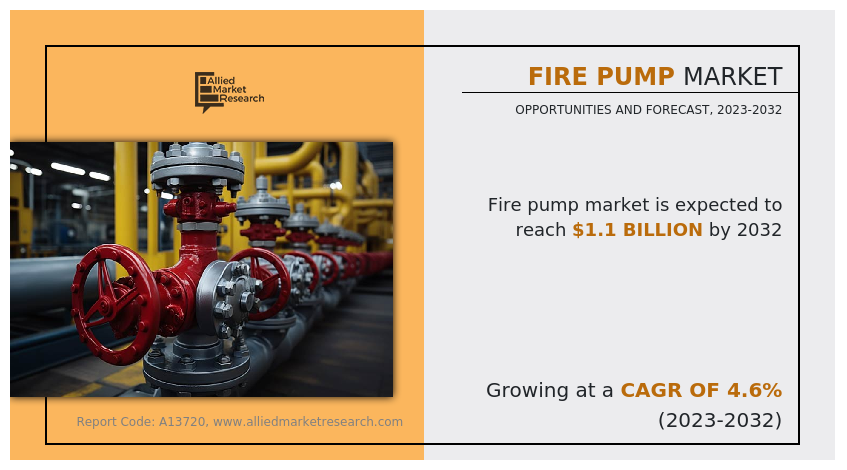
A fire pump is a critical component of fire protection systems designed to supply pressurized water or other firefighting agents to control or extinguish a fire. It plays a pivotal role in ensuring adequate and reliable water supply is available for firefighting operations. Fire pumps are employed in various industries and applications to safeguard lives and property from the devastating effects of fires. This versatile equipment is essential in a wide range of applications, including industrial facilities, commercial buildings, residential areas, and even on certain types of vessels.
Municipalities also heavily rely on fire pumps to support their fire departments. Fire hydrants connected to water mains are often insufficient to deliver the required pressure for effective firefighting. Fire pumps are strategically placed in pump houses or fire stations to boost water pressure and ensure a quick and powerful response to emergencies. The efficiency and reliability of fire pumps are critical for the successful operation of municipal fire departments and their ability to protect communities.
The marine industry in fire pumps plays a crucial role in ensuring safety. Ships and offshore platforms face an increased risk of fires due to the presence of flammable materials and limited access to immediate firefighting resources. Fire pumps on board vessels are designed to draw water from the surrounding body of water and supply it to firefighting systems. This capability is crucial for combating fires in maritime environments and preventing catastrophic incidents.
The integration of intelligent monitoring and control systems is a distinctive feature of modern fire pump technology. These systems utilize sensors and data analytics to continuously monitor the performance of the fire pump and associated components. Real-time data allows for predictive maintenance, helping to identify potential issues before they escalate into critical failures.
A unique consideration in the design and installation of fire pumps is the need for redundancy. Redundancy is a crucial aspect of the system, providing a backup for the primary fire pump in case it fails or needs maintenance. This ensures reliable and continuous operation to meet safety requirements. This dual setup enhances the reliability of fire protection systems, reducing the risk of a system failure during a critical moment. The redundancy factor is especially critical in applications where downtime or system failure could have severe consequences.
In smart buildings and the Internet of Things (IoT), fire pump systems are becoming interconnected with building management systems.
This connectivity allows seamless integration with other safety systems, such as smoke detectors and emergency lighting. In the event of a fire, the fire pump system automatically communicates with these systems to optimize the response, ensuring a coordinated and swift reaction to emergencies. The concept of modular fire pump systems is another area of exploration. Modular designs allow easier installation, maintenance, and upgrades. The approach involves replacing or upgrading individual components rather than the entire system, reducing downtime and minimizing the environmental impact typically associated with full equipment replacements. This modular design aligns with the broader trend in industrial design, focusing on flexibility and sustainability.
Smart and efficient systems in fire pump technology drives the growth of fire pump market. One significant advancement in fire pump technologies involves the integration of smart systems, utilizing the Internet of Things (IoT) for real-time monitoring and control. Smart fire technology such as FireConnect enables remote oversight through web-based and mobile apps, enhancing efficiency. The smart pump innovation aims to combat wildfires effectively and economically. In addition, electrical fire safety has progressed with DIY plug-in devices such as the Ting system, focusing on early detection and proactive monitoring. Modern fire pump designs prioritize efficiency by incorporating variable frequency drives (VFDs) and energy-efficient motors, allowing dynamic control aligned with actual demand, reducing energy consumption, and extending equipment lifespan.
High initial costs of a fire pump is expected to hinder growth during the forecast period. Fire pumps are essential for emergency response and come in diverse types and capacities, such as electric, diesel-driven, vertical turbine, and horizontal split-case pumps. The pump’s capacity, measured in gallons per minute (GPM) or liters per second (LPS), significantly influences its cost, with higher-capacity pumps having higher price tags. Initial installation costs are a substantial barrier for smaller businesses, especially in budget-constrained regions.
The costs associated with a water system includes various elements, including the procurement of equipment, installation services, and factors such as piping and control systems. In addition, the choice of water source, whether it be municipal, rivers, lakes, or on-site tanks, influences both costs and the complexity of the system. This variation requires additional components such as water treatment or filtration systems. This understanding is vital for businesses contemplating the integration of fire pump systems.
The fire pump market is segmented into product type, powered type, application, and region. On the basis of product type, the market is divided into horizontal split case, vertical split case, vertical in-line, vertical turbine, and end suction. By powered basis, the market is categorized into electric, diesel, gasoline, and others. By application, the market is segregated into field emergency, industry application, commercial application, and others. Region-wise, the market is studied across North America, Europe, Asia-Pacific, and LAMEA.
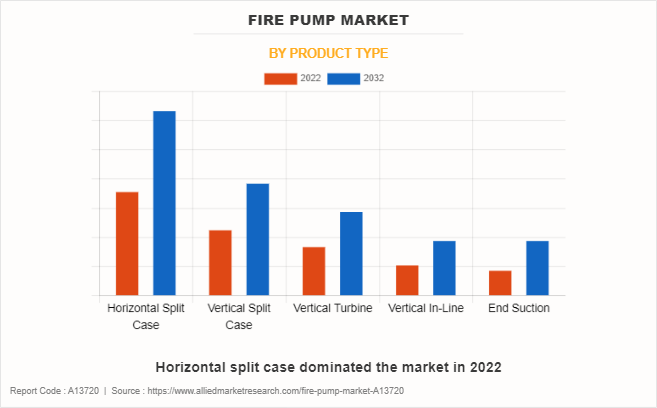
Horizontal split case fire pumps are widely used in diverse sectors such as fire protection for structures, municipal water supply, and safeguarding data centers. These pumps play a crucial role in ensuring rapid response and safeguarding critical equipment in data centers, emphasizing their significance in safety systems across various industries. All these factors increase the demand for horizontal split case.
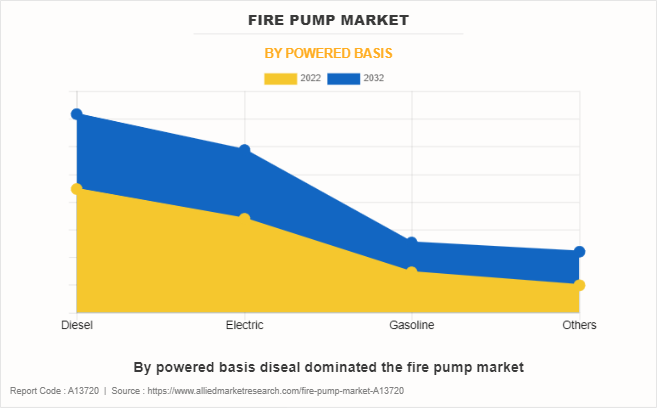
Diesel fire pumps with their self-contained design offer versatile placement options, independent of electrical outlets. Smart integration, employing sensors and real-time monitoring, enables proactive maintenance and remote oversight, boosting reliability. These innovations collectively elevate diesel fire pumps by adapting to diverse conditions, enhancing reliability, and streamlining maintenance for enduring fire protection.
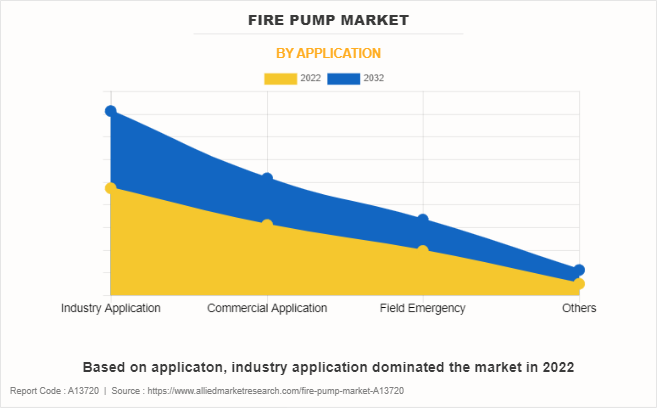
Fire pumps are vital for safety in transportation hubs such as airports, seaports, and train stations, ensuring swift response to emergencies in high-traffic areas. Hospitals rely on them to protect critical equipment and ensure patient care continuity. In addition, in retail spaces fire pumps bolster fire suppression systems, safeguarding merchandise and public safety. These pumps strategically placed, cover large areas, and maintain water pressure, mitigating potential fire risks, and protecting lives and valuable assets across diverse environments. All these factors increase the demand for fire pump in industrial application.
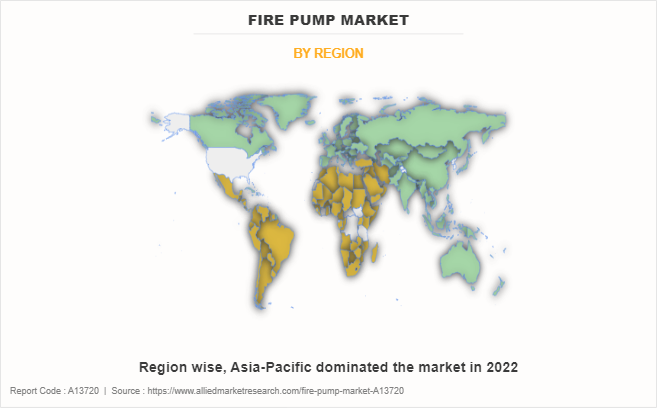
Rapid urbanization in China, India, and Singapore has led to towering structures, necessitating robust fire protection. High-rise buildings rely on fire pumps for pressurized water, crucial in emergencies. Several Asia-Pacific countries, including Malaysia and Australia, have a significant presence in the oil and gas industry. Fire pumps are crucial in these environments to manage the inherent fire risks associated with oil refineries and drilling operations. All these factors increase the demand for fire pump in Asia-Pacific.
The major players operating in the fire pumps market include Shaanxi Aerospace Power Hi-Tech Co. Ltd, Canariis Corporation, Grundfos Pumps Corporation., Xylem, Pentair plc, Cet Fire Pumps MFG Inc, EBARA CORPORATION, Sulzer Ltd., Shanghai Zhong Quan Pump Manufacturing Co. Ltd, Shanghai Liancheng (Group) Co., Ltd.
Apart from the above-listed companies there are many companies that manufacture fire pump market includes (Marlow Pumps, Fristam Pumps, End Suction Pumps, Ruhrpumpen, Hydro Pump Company, Allis Chalmers Pumps, Hayward Tyler, American-Marsh Pumps, Weir Group, Cornell Pump Company, Bell & Gossett, Metron Fire Pump Controllers, Paco Pumps, and others)
Historic trends of fire pump market:
- The use of hand-operated pumps for firefighting traced back to ancient Greece and Rome. In the 1600s, fire engines powered by hand-operated pumps started to emerge in Europe. These pumps were often mounted on wheeled carts for easier transportation.
- In the 1960s, the significant focus was on improving the efficiency and reliability of fire pumps. Advances in materials and manufacturing processes contributed to the development of more durable and high-performance pumps.
- In the 1980s, electronic controls started to be integrated into fire pump systems, allowing for better monitoring and automation. This enhanced the overall functionality and safety of fire pump operations.
- In 2010, the integration of digital technology continued to play a crucial role in fire pump systems. Remote monitoring and diagnostics have become more sophisticated, allowing predictive maintenance, and minimizing downtime.
- In 2020, the integration of artificial intelligence (AI) and machine learning has played a role in optimizing fire pump performance. These technologies help predict potential failures, streamline maintenance schedules, and improve overall system efficiency.
Key Benefits For Stakeholders
- This report provides a quantitative analysis of the market segments, current trends, estimations, and dynamics of the fire pump market analysis from 2022 to 2032 to identify the prevailing fire pump market opportunities.
- The market research is offered along with information related to key drivers, restraints, and opportunities.
- Porter's five forces analysis highlights the potency of buyers and suppliers to enable stakeholders make profit-oriented business decisions and strengthen their supplier-buyer network.
- In-depth analysis of the fire pump market forecast to determine the prevailing market opportunities.
- Major countries in each region are mapped according to their revenue contribution to the global market.
- Market player positioning facilitates benchmarking and provides a clear understanding of the present position of the market players.
- The report includes the analysis of the regional as well as global fire pump market trends, key players, market segments, application areas, and market growth strategies.
Fire Pump Market Report Highlights
| Aspects | Details |
| Market Size By 2032 | USD 1.1 billion |
| Growth Rate | CAGR of 4.6% |
| Forecast period | 2022 - 2032 |
| Report Pages | 270 |
| By Product Type |
|
| By Powered Basis |
|
| By Application |
|
| By Region |
|
| Key Market Players | Shaanxi Aerospace Power Hi-Tech Co. Ltd, Sulzer Ltd., Shanghai Liancheng (Group) Co., Ltd, Pentair plc, Cet Fire Pumps MFG Inc, EBARA CORPORATION, Grundfos Pumps Corporation, Shanghai Zhong Quan Pump Manufacturing Co. Ltd, Canariis Corporation, Xylem |
Analyst Review
According to the opinions of various CXOs of leading companies, the global fire pump market was dominated by the horizontal split case segment and the Asia-Pacific region is projected to register robust growth during the forecast period.
Smart and efficient systems in fire pump technology drives the growth of the fire pumps market. Efficiency in fire pump technology is closely tied to energy consumption and resource utilization. Smart systems employ energy-efficient components and algorithms to optimize pump operation. Variable frequency drives (VFDs), for instance, allow for precise control of the pump motor speed based on the actual demand for water.
However, high initial costs of fire pump are expected to restrain industry expansion. Fire pumps vary in types and capacities, including electric and diesel-driven, vertical turbine, and horizontal split-case pumps. Their specifications and applications influence costs, with higher-capacity pumps having higher prices due to their ability to deliver larger water volumes. The initial installation costs of fire pump systems become a barrier for smaller businesses, especially in budget-constrained regions. Expenses include equipment purchase, professional installation services, and proper setup of piping, valves, and control systems, crucial for effective emergency functionality.
Green and sustainable fire pump technologies are the coming trends of Fire Pump Market in the world.
The leading application of fire pump includes field emergency, industry application, commercial application, and others.
Asia-Pacific is the largest regional market for fire pump.
The top companies to hold the market share of fire pump includes Shaanxi Aerospace Power Hi-Tech Co. Ltd, Canariis Corporation, Grundfos Pumps Corporation., Xylem, Pentair plc, Cet Fire Pumps MFG Inc, EBARA CORPORATION, Sulzer Ltd., Shanghai Zhong Quan Pump Manufacturing Co. Ltd, Shanghai Liancheng (Group) Co., Ltd.
Smart and efficient systems in fire pump technology and growth in oil and gas exploration activities are the main drivers of the fire pump market.
The global fire pump market was valued at $0.7 billion in 2022, and is projected to reach $1.1 billion by 2032, growing at a CAGR of 4.6% from 2023 to 2032.
High initial costs of fire pump are the restraint factor of the fire pump market.
Loading Table Of Content...
Loading Research Methodology...


